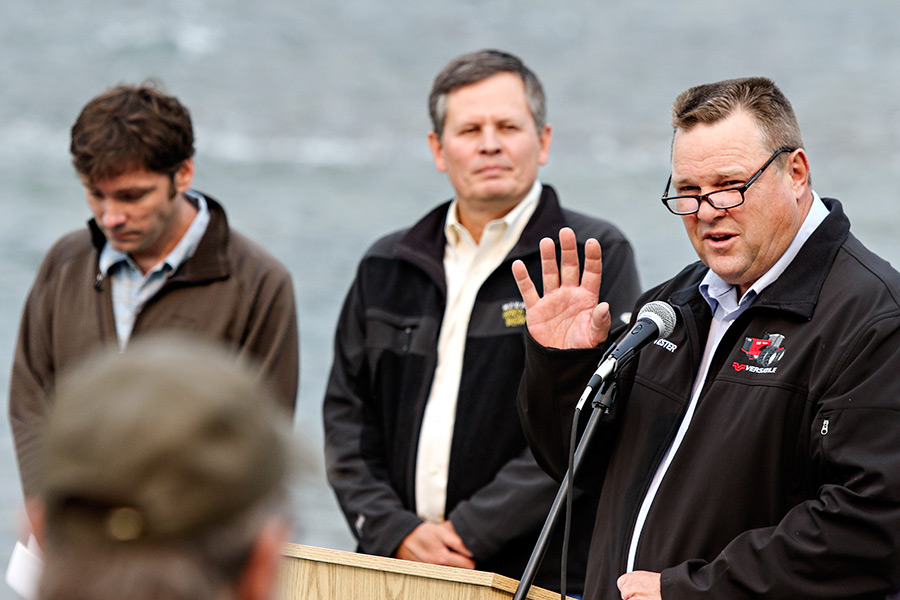Bipartisan Collaboration Preserves the North Fork
Senators, stakeholders converge on the North Fork Flathead River to commemorate historic conservation measure
By Tristan Scott
BLANKENSHIP BRIDGE – It didn’t matter that a noxious veil of smoke blotted out the peak-studded horizon on Aug. 24 because everyone who converged here was focused on the crystal-clear, coruscating waters of the North Fork Flathead River, which forms the western boundary of Glacier National Park.
A coalition of unlikely bedfellows gathered on the banks of the North Fork, just north of Columbia Falls, to commemorate a historic measure to protect the sparkling river that rolled beside them. Energy executives mingled among fish biologists, while land managers, business champions, community boosters, tree huggers, and tree cutters all milled about the rock-strewn shore for a single unifying reason – the North Fork Watershed Protect Act.
The measure to ban new energy development on 430,000 acres of wild and scenic river corridor has stood out for its singular brand of bipartisan support.
The Montana-made bill gained near universal esteem, even at the height of partisanship, and was hailed by conservationists, oil tycoons and politicians alike as a commonsense piece of legislation – 80 percent of energy leases in the area have been voluntarily released, and it dovetails with an effort by British Columbia’s parliament to place similar protections north of the border, on the headwaters of the Flathead River.
At the center of the scrum along the river stood Montana’s U.S. Senators – Democrat Jon Tester, a dirt farmer from Big Sandy, and Republican Steve Daines, a successful businessman from Bozeman.
Despite their weekly coffee clutches and open dialogue, the senators share more bones of contention than instances of accord, and fall on different sides of most political issues. It’s rare that they share the same stage during public appearances, and even rarer that they stand under the same spotlight to celebrate a conservation measure that they hammered out together.
As such, the symbolism of their perch this smoky morning at the confluence of two forks of the Flathead River was lost on none of the stakeholders who cheered and applauded as the senators took turns extolling the importance of protecting the North Fork.
“Today’s partisan politics is not known for its spirit of cooperation, but these two agreed on at least one thing, and that’s the North Fork,” said Michael Jamison of the National Parks Conservation Association, which organized the event to hail passage of the North Fork Watershed Protection Act last December.
The bill has been decades in the making, but emerged late last year as a rider to the National Defense Authorization Act, a piece of must-pass legislation that included a package of 70 national public land bills, the largest collection since the Omnibus Public Land Management Act of 2009.
Both senators said the bill is an example of bipartisan support for a commonsense legislation that will ensure future generations can enjoy the landscape.
“It turns out that protecting a landscape on the borders of a national park isn’t as controversial as you might think,” Tester said.
Both senators gave credit to the collaborative efforts of those in attendance, as well as to former U.S. Sen. Max Baucus for his early and lasting involvement in working to protect the North Fork.
Baucus, whose retirement to become ambassador to China cast doubt on the bill’s future, did not attend, but said in a statement the bill’s passage was the culmination of decades of work he and the conservation community began more than 40 years ago.
“This has been a long journey, and we really stand on the shoulders of a lot of the work that you all began. You took this and carried a lot of that water for many, many years,” Daines told the crowd Aug. 24.
Bij Agarwal, of ConocoPhillips, the first company to relinquish its energy leases, said he was honored to see the scenic river corridor for himself.
“In 2010 we were the first company to release its leases on the North Fork and establish this preservation status,” he said. “We hope that generations to come will be able to enjoy this beautiful area.”